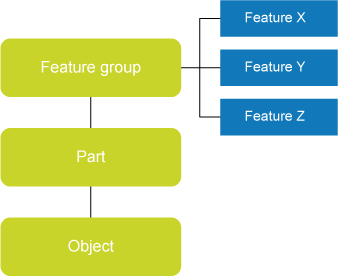
Features can be defined for parts and objects in Isah. There are two types of features: configuration features and classification features.
A configuration feature is a feature for which options are available. For example, the feature 'Color' could have the options 'Red', 'White', and 'Black'. When a part is assigned the feature 'Color', configuration is required at order time, as the customer must choose the desired color.
A classification feature immediately specifies a part. The part might be a chair, and the feature is the color 'Black'. If the customer orders a black chair, he cannot choose any other color. Therefore, a classification feature has no options.
In Isah, features are available for:
When adding or changing a part, you can copy the features of the feature group you are linking to the part. When adding or changing an object, you can copy the features of the part on which the object is based.

Note: At lower levels (on part or object level), features and options are merely added or changed. They are not deleted. This means that if features or options are deleted at a higher level (at the level of a feature, a feature group, or - in the case of objects - a part), they are not automatically deleted at lower levels as well. You can still manually change, delete, or add features of a part or object. To do so, select the part on the Parts form and then click the Features button. A list will be displayed, containing all features that are linked to the part.
Features can be used in the Sales Configurator, the Production Configurator, and in the Objects module.
The Sales Configurator
The Sales Configurator is specifically designed for products that are available in different versions, such as a part that can be delivered in different colors, or a machine that is available with different engine powers. You can use the Sales Configurator to enter customer-specific models or product lines.
In Isah, a standard part is entered, to which features (for example 'Material' or 'Color') are added. The features are assigned options ('Wood', 'Stainless Steel', 'Plastic', and 'Red', 'Black', 'White', 'Silver'). You can made the options interdependent, for example if a product is only available in silver if the customer chooses stainless steel as the material. The Configurator prevents incorrect choices, as incorrect choices are automatically excluded.
When the standard part is added to an order, it can be configured with the help of the Sales Configurator. Quiz-type questions will be displayed ("Which material does the customer want?"), and the answers are registered with the order, so the configuration requested by the customer is recorded in Isah straight away. The Configurator prevents forgotten questions or incorrect configurations (such as "red stainless steel").
The Sales Configurator has a number of important advantages:
The Production Configurator
The Production Configurator allows engineers to classify a calculation of parts based on features. They use the classification features.
You could, for example, register the dimensions and the capacity of a part, to allow you to search for parts by these features. You might want to use these data when passing on order details to the purchase department. Also, parts can be located quickly by searching for features, for example if you want to use the data for a drawing of a similar part.
If you are creating an offer for a machine, the type of engine might not be known yet. This information is relevant during the design of the machine, however, as an engine with a particular capacity may be required. In that case, you could register the feature 'Capacity Type X' with different engines, allowing you to retrieve a list of all engines with capacity 'X'.
Objects
When using objects, you can use features to add company-specific data to an object.